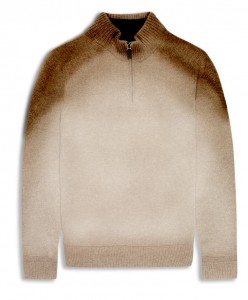Gloves, Mittens and Glove Linings
Manufacturing gloves, mittens and glove linings that provide greater warmth at the fingertips provides greater warmth and comfort to the user. This is accomplished by graduating higher insulated fibers or yarns toward the fingertips. This will reduce palm sweat, and increase comfort, dexterity and wearability in cold conditions. The current practice uses a single yarn type or a lining of one fabric type. Warmer Weave’s knitted fabric graduates higher insulated threads into the fingertip area with less graduation toward the palms. Warmer Weave’s fabrics for use with gloves, mittens and linings can be constructed with various fibers such as Thinsulate™ in conjunction with polyester or other types of synthetic or natural fibers.
Socks
Manufacturing socks that favor warmth at the toes give greater comfort and warmth to the wearer. This is accomplished by graduating higher insulated fibers or yarns toward the toes. Warmer Weave’s graduated fabrics reduce foot sweat in “hotspots”, and increase comfort and warmth in cold spots. The current practice is the use of one type of yarn or a lining constructed from one type of fabric. Warmer Weave’s fabrics graduate higher insulated threads toward the toes and less toward the heel of the foot. Warmer Weave’s fabrics for use with socks can be constructed with various fibers such as Thinsulate™ in conjunction with polyester or other types of synthetic or natural fibers.
Shirts and Blouses
Currently most shirts and blouses are manufactured using one type of fabric. Using interwoven graduated fabrics provides greater comfort to the wearer by minimizing the well-known “hot-and-cold” zones in clothing and apparel. For example, arms, shoulders, sides and other affected areas become cold during rest or stress while the body’s core and underarm area remains relatively warm. Using Warmer Weave’s graduated woven fabrics, greater insulating factors, warmth and comfort are graduated into these areas providing the wearer with a natural, equally distributed feeling of warmth and comfort. Warmer Weave’s fabrics for use with shirts and blouses can be constructed with various fibers such as Thinsulate™ in conjunction with polyester or other types of synthetic or natural fibers.
Slacks and Pants
Currently most pants and slacks are manufactured using one type of fabric. Using interwoven graduated fabrics provides greater comfort to the wearer by minimizing the well-known “hot-and-cold” zones in clothing and apparel. For example, an individual’s crotch area is often warm during normal activity and uncomfortably warm during hi activity, such as while sporting. Using Warmer Weave’s graduate woven fabrics, greater insulating factors, warmth and comfort are graduated into these areas providing the wearer with a natural, equally distributed feeling of warmth and comfort in the thigh and lower leg area. Warmer Weave’s fabrics for use with slacks and pants can be constructed with various fibers such as Thinsulate™ in conjunction with polyester or other types of synthetic or natural fibers.
Clothing that requires protective areas often needs added insulation. Warmer Weave’s graduated woven fabrics can provide areas in apparel with graduated protective properties, such as undergarments or outer apparel with more/less insulated fabrics around protected areas of the body. Examples of protective wear that will benefit from Warmer Weave’s graduated woven fabrics can include, for example:
• Chef’s Uniforms
• Combat Uniforms
• Police Uniforms
• Construction Uniforms
